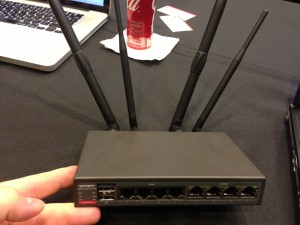Opengear gave the second presentation to delegates at Networking Field Day 4, and I was very interested to learn how far the humble terminal server has come since the days when I was configuring Cisco 2511 access servers for console access to data center devices.
If you run a data center and don’t already know about Opengear, I’d certainly recommend reading on, as they are doing some things that I think got everybody in the room excited for one reason or another.
The Products
Toby Smith (Sr Software Engineer) and Jared Mallett (Product Marketing Manager) gave us a pretty good presentation on their advanced console management solutions are capable of. The aim of the products is to provide business continuity by providing out of band access to your devices. The reality though is that they’ve built devices that could potentially be put to so many other uses, the possibilities are pretty much limitless.
I’ll link to the videos of their presentation later in this post – there’s no point me regurgitating their product line for you here. However, I noted down what I felt were some key points about their solution, so I’ll highlight those here.
- The devices are built using uClinux and other open source software, and have military level security approval
- These are more than basic term servers – they also have the ability to route intelligently (wired versus 3G wireless backup), perform NAT and firewall connections – though obviously at moderate speeds and without dynamic routing protocols, so don’t expect to put one in your network core any time soon.
- Some devices offer just serial ports, but others include Ethernet too – perfect for DRAC, iLO, aLOM, etc.
- 1 to 32 ports available
- Optional contacts for environmental sensors, door switches, relays, alarms, triggers, etc.
- Optional built-in modem
- Programability – you can customize the heck out of these devices
- Feature consistency across the product range – the small devices run the same way as the big ones
- Options for 3G cellular out of band management including a ‘call home’ capability. The ability for the opengear device to establish an outbound connection is essential given the prevalence of NAT/PAT on 3G wireless networks.
- Local logging of activity – perfect for paranoid military applications among others, but these devices can keep a record of everything that is done on a port, and store it locally so there’s a copy even if a remote logging server is unavailable.
- Inline actions based on activity – e.g. you can monitor for a phrase like “write erase” being typed, then intervene to cancel the command and protect your device. To see that kind of trigger in action, read Jeremy Stretch’s excellent post over at Packetlife.net. In a similar fashion, you could monitor the console stream for a given error message and trigger an alerting action (e.g. email, SNMP trap), a power cycle or a set of commands issued through the self same serial port!
- Authentication options include local (to the device), TACACS, RADIUS, LDAP and Kerberos.
- Opengear has a central management system (CMS) to pull together many remote devices in one place.
- The Opengear devices can control RPC/PDU devices locally via SNMP and similar. In fact you can set up a hotkey so that during your console session you can pull up a power menu and power cycle your device via the RPC. The mapping of RPC ports to serial ports can be set up in the Opengear device so that there’s no question that you are powercycling the right device.
- Integrates with network management systems, e.g. Nagios, Solarwinds Orion, Zenoss and similar.
- Web interface for configuration, but if you choose to SSH to the device you have root access, and you can customize as much as you want.
Probably the biggest selling point for me here was the open nature of the software, and the fact that you get root access to the device. That of course gives you the power to bork the device, but it also gives such phenomenal flexibility to how you can react to events, that it more than makes up for any risk.
Use Cases
Opengear shared a few use cases that were a little more interesting than the standard console server deployments, and it was these that started my head going on things we could do with this hardware. For example:
- RFID sensors and a weather-protected 3G console server configured to send RFID scan data back from a floating fish farm in the sea. Solar panels are used to power the equipment.
- The Opengear SD4001 (a one port console server) is being used to log serial data in gaming machines.
- Solar panel monitoring
- Roadside cabinets
- Using 3G capabilities to report back data from weather buoys floating in the Atlantic (leading to the quote “we have a bunch of product floating in the Atlantic”)
- One data center that used switches on cabinet doors as a trigger input to the Opengear device so that in turn the Opengear would trigger a webcam mounted inside the cabinet to start taking pictures so they would have a record of who opened the cabinet.
Given that you can code triggers and actions to do pretty much anything you want, there are literally thousands of potential applications for this hardware. Compare that to something like the ubiquitous Cisco 2511, and you realize that having a device without boundaries beats the pants off having a single-mission device with a limited interface and restricted set of features.
Playing With an ACM5004
Opengear were kind enough to provide delegates with one of their entry-level console servers, the ACM5004-G. This device has 4 serial ports, one Ethernet, one USB (for flash memory log storage) and a 3G radio – ostensibly for backup purposes if your wired connection is unavailable, but also usable as a primary connection if that suits your purposes. I will give a more in depth review of the hardware itself in a forthcoming post, but I think I can say without spoiling too much, that the hardware seems pretty easy to configure, and I was connecting to serial ports within 10 minutes of powering it up.
View The Presentations
There videos have been helpfully split up into seven pieces, as follows:
Introducing Opengear at Networking Field Day 4
Opengear Hardware Overview
Opengear Software Overview
Introducing the Opengear Customer Base
Opengear Advanced Console Management Demo
Cellular Out-of-Band Management and Call Home with Opengear
New Platforms, New Markets, and the Internet of Things
If you’re able to watch the videos, I’m sure you will also be seeing the potential for these products in almost any network, and if you’re like me, you’re figuring out how to use them to do things they were never meant to do!
Conclusions
I loved this presentation, and I’m excited about the products we were shown. As a geek I love tools that can solve problems for me, and Opengear prsented some products here that totally open the door to creative solutions to unusual problems. Similar to my other NFD4 reviews, I have to say that I cannot yet proactively recommend Opengear simply because in this case, while I have the hardware to play with, I’ve not had enough hands on time to put my recommendation behind it. However, if the reality lives up to the presentation, Opengear will definitely be on my list of vendors next time I evaluate out of band and console management devices.
Disclosure
Opengear was a paid presenter at Networking Field Day 4, and while I received no compensation for my attendance at this event, my travel, accommodation and meals were provided. I was explicitly not required or obligated to blog, tweet, or otherwise write about or endorse the sponsors, but if I choose to do so I am free to give my honest opinions about the vendors and their products, whether positive or negative. Opengear provided me with an entry-level console management device (ACM5004-G), and I will be sharing my thoughts on this shortly.
Please see my Disclosures page for more information.






Leave a Reply